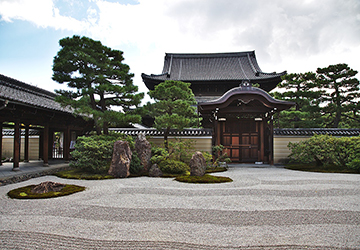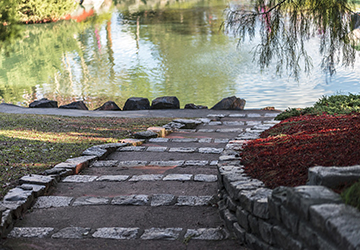Our backyards are our refuge where we can unwind and relax after a stressful day. Enjoying the light winter breeze or a cool drink in the summer under the shade while enjoying nature's beauty calms our senses and gives us a chance to find inner peace. The sights and sounds play a significant role in attaining serenity.
Zen gardens, taking inspiration from Japanese Buddhist monks, allow for simple yet effective design to bring peace by balancing your inner self's yin and yang. If you put your mind to it, it is easy to achieve, so we have some great approaches you can incorporate into your backyard garden.
What is a Zen Garden?
In the traditional sense of meaning, the concept of Zen Garden comes from the word Kare Sansui. This Kanji word depicts a landscape of naturally arranged rocks, plants, and other natural elements that give a sense of peace. When human innovation mixes with natural landscapes, including adding bridges, fountains, lighting, and so on, it becomes a Zen Garden.
More often than not, the garden is an enclosure with fences or walls all around to separate and secrete from outside elements and the world. While mostly natural, you can still add natural inspirations into the landscape to look and feel like a Kare Sansui.

What Crucial Aspects You Must Consider When Building Your Zen Garden.
While you can take inspiration from your travels or view an online tour of some of these gardens, here are some Zen aspects that should be added for more authentication.
Sight Picking
It would help to consider whether you are converting your backyard into a Zen Garden or designating a space where you can find peace or meditate.
Research
Visit Zen Garden if you have them nearby, or you can take some online virtual tours to understand the structure of the actual gardens. You can also view YouTube videos or read articles that will help you understand the thought process behind it. You can also find books that detail pictorially which Zen Garden aspects are essential.
Guiding Principles
There are seven guiding principles that you should follow and learn from the above resources how to implement them. These principles are:
1. Koko – Don't be extravagant.
2. Kanso – Keeping things simple.
3. Shinzen – As close to nature as possible.
4. Fukinsei – Keeping balance and allowing asymmetry in your garden.
5. Yugen – Allow things to remain mysterious, and don't let elements pop out.
6. Datsuzoku – Adding enchanting and magical elements that are unconventional.
7. Seijaku – Bring stillness to your well-being and surroundings.
Designing Phase
Now that your research is done and you have cleared out many ideas, design the best garden or take a professional landscaper's help.
A list of Ideas and Inspirations to Create a Zen Garden
Here is a perfect set of solutions to transform your garden from just a backyard into a sophisticated Zen Garden, a complete and functional peaceful retreat.
1.Making an Entrance
Though open and minimal, Zen Garden always has an entrance, adding the feeling of mystery through which you enter an alternate world. In Japanese culture, shrines or temples would have a Torri entrance believed to rid you of all the evils and demons, which you can install as an entrance. You can also look online to search through other gate styles.
The entrance tells a lot about what you will be experiencing inside any place, so this is the first crucial step in creating a Zen Garden in your backyard.

2.Steppingstones and Their Picture Perfection
We recommend placing regular carved stones leading a path from your home to your shed, a tree, or a small pool in your backyard. But you can put these stones around a central tree or a fountain, enhancing the feeling of mindfulness.
These stones don't need a practical design, just stepping stones to elevate yourself from the difficulties of this world, allowing you to focus on the larger picture.
3.The Water Effect or Feature
Most Japanese Zen Gardens are built around a pond or a waterbed, adding the element of life and creating a sense of light and peace when you look at the expanse of the water. It also cools your surroundings during the summertime and is impressive to hold barbeque parties in the winter. If you cannot invest in such an endeavor, installing a large basin of water passing through a bamboo dipper adds the effect.
4.Enchanting Bridges
What inner peace is complete without self-reflection and contemplation, and what better to represent this perspective than by adding a magical and enchanting bridge to your landscaping? The view of such a bridge allows you to think deeply about different transitions in your life and encourages you to start a journey in self-found peace and freedom.
Add a small bridge over a flow of water or simple representations of an expanse with the help of pebbles on a sandy pathway protected on the sides with large stones will do the trick.
5.The Island of Peace
Zen Gardens captures this perfectly in many ways. It may have an island inaccessible due to a water expanse or a small set of bridges leading to it. Both represent the struggles in your life, presenting a goal you can reach through building bridges or traversing the open waters.
You can make a pasture in the middle of the surrounding sand area or use smaller pebbles to create the effect. Both are popular elements of a Zen Garden.
Final Serene Thoughts
The purpose of the Zen Garden is to bring peace and serenity into your life, so don't be extravagant about building it. It is your private place and a place to meditate. You should in no way flaunt or promote it as an achievement. Allow others to encompass the purpose if desired and not force on others. These small things will help you what you set out for if you understand and follow these instructions. Keep updated for more informative content such as this.


